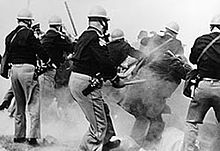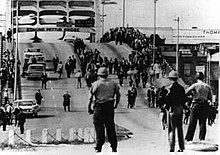Selma-to-Montgomery Marches
The Selma to Montgomery marches were three marches in 1965 that the political and emotional peak of the American civil rights movement (Civil rights movement) marked. They were the culmination of the struggle for suffrage under the 1964 Civil Rights Act in Selma, Alabama , started by Amelia Boynton and her husband. Boynton brought many leaders of the African-American Civil Rights Movement to Selma, including James Bevel , who was the first to call for the march, Martin Luther King Jr. and Hosea Williams .
prehistory
Selma was the administrative seat of Dallas County , Alabama. The 1960 census found that the county's population was 57% black ; in the 1961 elections, of the 15,000 or so blacks of voting age, only 130 were registered as voters. The causes were Jim Crow laws , which tied voter registration to tax classes, excluded illiterate people from voting, included knowledge and comprehension tests in eligibility for voter registration, as well as economic pressure and naked violence.
Amelia Boynton and her husband Sam had been involved in educational programs for blacks since the 1930s. Since 1954 they had known Martin Luther King , the pastor at the time in the state capital Montgomery , who had helped organize the Montgomery bus boycott in 1955/56 and since then had become the national leader of the Southern Christian Leadership Conference (SCLC) and the entire civil rights movement. The Boyntons had also tried to recruit blacks for voter registration since the late 1950s, and to do this they formed the Dallas County Voters League (DCVL). Their work was supported by the SCLC and its project leader, James Bevel .
Since 1963, the Student Nonviolent Coordinating Committee (SNCC) was active in Selma , an organization of schoolchildren and students that used non-violent methods to promote, among other things, the registration of black voters. Sam Boynton died in May 1963. At his memorial service, representatives from DCVL and SNCC wanted to talk about Boynton's life and goals, so Sheriff Jim Clark had the church rearranged to prevent the ceremony. Several hundred blacks were not intimidated, took part in the celebration and said goodbye to Boynton. That summer, Bernard Lafayette , one of the student leaders, was beaten almost to death by members of the Ku Klux Klan . 32 black teachers registered as voters and were dismissed without notice by the all-white school board.
On October 7, 1963, civil rights activists organized a mass enrollment of over 350 people in the electoral register. The registration committee delayed enrollment throughout the day, so that applicants had to wait in the blazing sun from early morning until late afternoon. Only around 25 people were admitted to the committee that day, and most registrations were rejected after the exams. Sheriff Clark had members of the SNCC tortured and arrested with electric batons who wanted to put up posters to indicate registration or bring water and food to those waiting.
Following the enactment of the Civil Rights Act of 1964 , Amelia Boynton ran for the Democratic Party's candidacy for the House of Representatives that same year and achieved 10% of the vote with only 5% of black voters.
On July 6, 1964, around 50 black people wanted to register as voters. Sheriff Clark had them arrested when they entered the administration building. On July 9, a local court issued an order banning civil rights organizations from holding gatherings of three or more people. This blocked the movement's work for around six months.
In winter Boynton asked the SCLC and Martin Luther King for help, in December the organization sent an organization team led by James Bevel to Selma. On January 2, 1965, Martin Luther King held a meeting with hundreds of attendees in Brown Chapel and defied the ban by the local court. On the registration days in January and February, there were again mass registrations.
Further rallies and enrollments were organized in neighboring counties of Perry , Wilcox , Marengo , Greene and Hale . On February 17, a state police officer shot a young man in Marion , the administrative seat of Perry County, who died eight days later from his injury.
The first march
The first march took place on March 7, 1965 and was in response to the death of Jimmy Lee Jackson, who was shot dead by security forces on February 17, 1965 during a civil rights demonstration. About 600 people marched from Selma, led by John Lewis , who was co-organizer of the 1963 March on Washington with Martin Luther King's I have a dream speech. Outside the city, the police stopped the marchers on the Edmund Pettus Bridge with clubs and tear gas , making the day "Bloody Sunday". This prevented the protest march on US Highway 80 , which was supposed to lead to the capital of the state of Alabama, one of the eleven slave-owning states ( southern states ) that split off from the Union in 1860/1861 after Abraham Lincoln was elected US president .
The second march
The second march, to which Martin Luther King called on March 9, 1965, did not reach the capital Montgomery of Alabama either , as King had to turn back in front of the Edmund Pettus Bridge for de-escalation reasons and under pressure from members of Congress. After the conclusion of the second march, one of the participants, the Unitarian clergyman James Reeb, was murdered by white racists.
The third march
The third march, which began on March 21, 1965 and lasted five days and four nights, reached the capital, Montgomery, about 86 km from Selma on March 24. The protesters marched along US Highway 80 and were protected along the way by US Army soldiers and members of the National Guard . In the evening the concert "Stars for Freedom" took place there, at which Harry Belafonte , Tony Bennett , Frankie Laine , Peter, Paul and Mary , Sammy Davis, Jr. and Nina Simone performed, among others .
The following day, around 25,000 people marched in front of the State Capitol Building, where King gave a speech.
Remembrance and memorials
In 1996, the route of the then marches was designated by the United States Congress as the Selma To Montgomery National Historic Trail and included in the National Trails System . Like all National Historic Trails, it is a decentralized memorial for which several locations are signposted and advertised together. The National Park Service maintains the Lowndes County Interpretive Center visitor center with a museum at the site of the historic tent city about halfway down the train route . Guided tours and lectures are offered there every day. The NPS plans to open another visitor center in Selma by 2016 and a third in Montgomery in the long term.
There is also the Martin Luther King, Jr. Street Walking Tour in Selma , a walking tour of important places in the city that are connected to the events of the time. Other locations related to the Selma marches include the private National Voting Rights Museum , the Slavery & Civil War Museum, and the Edmund Pettus Bridge on the city limits.
In Montgomery, the National Historic Trail includes the Rosa Parks Museum , Dexter Avenue King Memorial Baptist Church , the Alabama State Capitol, and the Civil Rights Monument .
In the protest song Eve of Destruction by Barry McGuire , composed in 1965, the line of text " Then take a look around to Selma, Alabama " recalls the events in Selma as an example of the violence of the state organs within the USA.
Movies
The marches are discussed in the following films:
- A Time for Justice (Oscar-winning short documentary film)
- Eyes on the Prize (documentary about the civil rights movement)
- Wallace (feature film about the life of the Governor of Alabama)
- Selma (feature film from 2014 with David Oyelowo in the lead role as Martin Luther King)
Quotes
“As you can see, the days of March 1965 were the most important in American history. Because the realization of the ideas and promises of the constitution have never been more tangible than there. "
literature
- Barbara Harris Combs: From Selma to Montgomery: The Long March to Freedom. Routledge, London 2013, ISBN 978-0-415-52960-0 .
Individual evidence
- ^ Howard Zinn : SNCC - The new Abolitonists. Beacon Press, Boston 1965, 153
- ^ Veterans of the Civil Rights Movement: Selma - Freedom Day
- ↑ Zinn, p. 163
- ^ Veterans of the Civil Rights Movement: The Selma Injunction
- ^ Salmond, John A. "My Mind Set on Freedom". P. 129.
- ↑ Speech by Martin Luther King: Our God Is Marching On! , March 25, 1965
- ↑ National Park Service: Selma to Montgomery NHT - Centennial Strategy Report 2007 (accessed January 26, 2010; PDF file; 244 kB)
- ↑ Verena Lueken: Beyond Eden on the way in Alabama, in: FAZ No. 256, November 3, 2018, p. 9.
Web links
- National Park Service: Selma To Montgomery National Historic Trail (official site; English)




